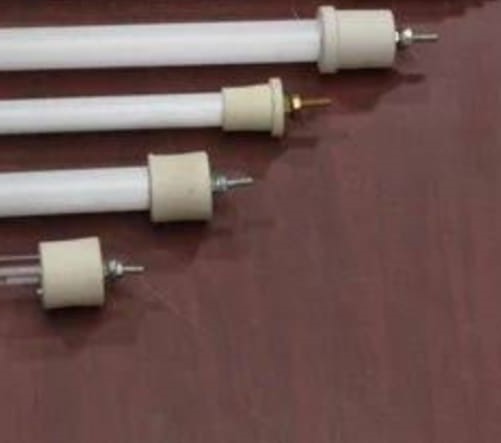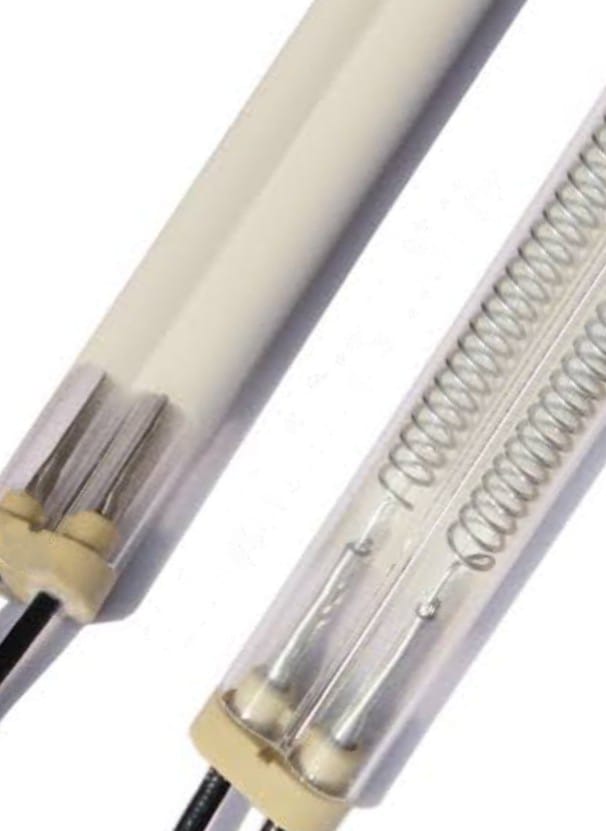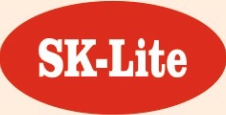Infrared Lamp (Heater)
Quartz Halogen Lamps:
These lamps utilize a quartz tube and a tungsten filament filled with a small amount of a halogen gas (like iodine or bromine). The halogen gas helps to regenerate tungsten atoms that evaporate from the filament, which extends the lamp’s lifespan and allows for higher power density.
- When electricity flows through the tungsten filament, it heats up to a high temperature, emitting infrared radiation.
- The infrared radiation is then either directly radiated or focused by a reflector towards the desired target, producing heat.
- Quartz halogen lamps are particularly efficient at producing intense heat due to their ability to maintain high filament temperatures.
Application:
- Packaged Drinks/Aeriated Drinks/Packaged edible Oil – PET packaging of packaged drinks & aeriated drinks, PET packing of edible Oil.
- Food Industry – Food processing, Dehydrating Vegetable & Fruit, Moisture removal from food grains.
- Leather Industry – Leather processing & Leather shoe Making industry.
- Plastic Industry – Curing Adhesive in tape making, Dehydrating plastic Granules & Powder, Preheating of plastic before Plastic forming/Thermoforming.
- Pharmaceuticals – Glue drying in surgical tapes during making, Bottle sterilizing.
- Printing – Drying a printing ink.
- Pulp and Paper Industry – Drying paint on rubber item,
- Rubber Industry – Drying paint on rubber item,
- Textile Industry – Drying Fiber, Fabrics, paint curing on printed fabrics.
- Electrical Industry – Drying of Armature, motor, baking of Varnish on motor winding coil.
- Electronic Industry- drying, Preheating, Curing and solder of PC Board.
- Automotive Industry – Paint & Putty baking, Powder coating, Preheating parts prior to push fitting. Drying washed parts.

Short wave Infrared lamp (SW)
Also known as short wave infrared heaters, transmit heat through electromagnetic radiation, making them efficient and rapid heating solutions. They are commonly used in industrial applications like paint curing, heating plastics, and drying processes. SWIR lamps operate in the 0.9 – 1.7 μm (or sometimes 0.7 – 2.5 μm) wavelength range. They are known for their high efficiency in converting electrical energy into heat, with some reaching 80% efficiency.

Medium Wave Infrared Lamp (MW)
Mid-wave infrared or MWIR is a subset of the infrared band of the electromagnetic spectrum, covering the wavelengths ranging from 3µm to 5µm (3,000 to 5,000nm). Plastics, water and other solvents absorb medium wave radiation
especially well. The use of medium wave infrared emitters helps in
the effective drying of paints and lacquers and in the economical
processing of plastic foils and sheet. Because of their long life,
these emitters are best suited for continuous processes. Surface
films and very thin materials are heated up extremely efficiently.
Medium wave infrared emitters are manufactured in any require

Fast Response Medium Wave Infrared Lamp (FRMW)
As the name suggest that FRMW lamp available in higher watt density within the medium wavelength. FRMW infrared lamps heating and cooling process is faster than medium-wave IR lamps. These lamps are cost-effective alternative to carbon filament infrared lamps.

Ceramic Infrared lamp
Ceramic elements work within the temperature of 300°C to 700°C. Ceramic infrared heaters wavelengths are in the 2 – 10 micron range. This range radiation useful in heating of Plastics and many other materials. Thus, ceramic heater becomes most popular infrared radiant emitter in the market for forming/Thermoforming of plastic material.

Short wave Single Tube IR Module Details
Industrial heating modules are prefabricated heating elements and insulation designed for a wide range of thermal processing applications. They offer efficient heat distribution, versatility, and are suitable for both laboratory and production furnaces.
| Short wave Single Tube IR Module Details | ||||||||
| Sr. No. | IR lamp | Module Size | ||||||
| Type | W | V | OL | HL | L | W | D | |
| 1 | NM | 500 | 240 | 212 | 127 | 310 | 80 | 55 |
| WM | 310 | 145 | 80 | |||||
| 2 | NM | 1000 | 240 | 348 | 254 | 460 | 80 | 55 |
| WM | 460 | 145 | 80 | |||||
| 3 | NM | 1600 | 240/416 | 500 | 406 | 610 | 80 | 55 |
| WM | 610 | 145 | 80 | |||||
| 4 | NM | 2000 | 415 | 626 | 508 | 725 | 80 | 55 |
| WM | 725 | 145 | 80 | |||||
| 5 | NM | 2500 | 415 | 728 | 635 | 825 | 80 | 55 |
| WM | 825 | 145 | 80 | |||||
| 6 | NM | 3000 | 415 | 850 | 765 | 975 | 80 | 55 |
| WM | 975 | 145 | 80 | |||||
| 7 | NM | 3000 | 415 | 950 | 850 | 1060 | 80 | 55 |
| WM | 1060 | 145 | 80 | |||||
| 8 | NM | 4000 | 415 | 1120 | 1020 | 1225 | 80 | 55 |
| WM | 1225 | 145 | 80 | |||||

Electronic Controls
An electronic controller is usually used, if the wiring effort is too high for certain functions/systems, logic connections are required, or system processes need to be simplified. Most technical devices and systems in all economic sectors require electronic controllers.
Electronic control systems use electronic components to regulate other devices or systems, often relying on a loop that compares input and output signals to achieve a desired outcome.
They can be found in digital controllers for sensors, power electronic controllers for various applications, and temperature controllers for specific needs. Additionally, programmable logic controllers (PLCs) and electronic control units (ECUs) are used in industrial automation and vehicles, respectively.

Industrial Heating Oven
An industrial oven is a machine used to create extremely high temperatures to heat treat materials, condition metals, and cure metal coatings. Their most distinguishing feature of industrial ovens is the heating chamber that controls a specific temperature level and completes drying, curing, and baking tasks.

Punematic Cyclinder
Also known as air cylinder, is a mechanical device which uses the power of compressed gas to produce a force in a reciprocating linear motion.
Pneumatic cylinders are versatile devices that convert compressed air into linear motion, making them ideal for a wide range of applications, particularly in industrial automation and robotics. Generally Pneumatic cylinders are used to perform work with precision, speed, and repeatability. it helps to move object, hold & uses in robotic uses.
Several manufacturers offer pneumatic cylinders, including SMC Corporation, Festo, Airmax Pneumatics, Janatics and others.

Punematic Fittings
Pneumatic fittings are essential components in pressurized gas systems, used to connect pipes, tubes, and hoses. They are crucial & ensuring tight seals and efficient air flow in pneumatic systems. These fittings come in various types and materials, each suited for specific applications and pressure requirements.
- Types of Pneumatic Fittings:
Tube-to-Tube: These fittings connect two sections of tubing, straight or at an angle. - Tube-to-Port: These fittings connect tubing to a port on a pneumatic component like a valve or actuator.
- Pipe-to-Tube: These fittings connect a pipe to tubing.
- Pipe-to-Pipe: These fittings connect two sections of pipe.
- Quick Connect Fittings: These fittings allow for rapid connection and disconnection of pneumatic tubing.
- Threaded Fittings: These fittings use threads for connection and sealing.
- Push-in Fittings: These fittings connect tubing by pushing it into a fitting.
- Check Valves: These fittings allow fluid flow in one direction and prevent backflow.
- Y and T Fittings: These fittings are used to create branches in a pneumatic system.
Materials:
- Brass: Common for its machinability and corrosion resistance.
- Stainless Steel: Offers excellent corrosion resistance and durability.
- Plastic: Used for cost-effectiveness and chemical resistance.
- Composite Materials: Offer high strength, durability, and chemical resistance.

PU Tube
PU tubes, also known as polyurethane tubes or PUR tubing, are flexible pipes made from polyurethane material. They are widely used in various industries, including pneumatics, automation, and medical applications, due to their durability, flexibility, and resistance to abrasion, oils, and chemicals. PU tubes offer advantages over other materials like PVC and nylon in certain applications, particularly where high pressure, tight bends, and frequent movement are involved.
- Common Applications:
Pneumatic Systems:
PU tubes are widely used in pneumatic control systems, air lines, and various pneumatic tools and equipment. - Automation:
They are used in automation systems, robotics, and other automated machinery where flexible and durable tubing is needed. - Medical Applications:
PU tubes can be used in medical devices where clean air and precise pressure control are required. - Food and Beverage:
Specific grades of PU tubes are suitable for food and beverage applications when certified for food-grade use. - Other Industries:
PU tubes find applications in automotive, agriculture, and various other industries where their flexibility, durability, and chemical resistance are beneficial.
